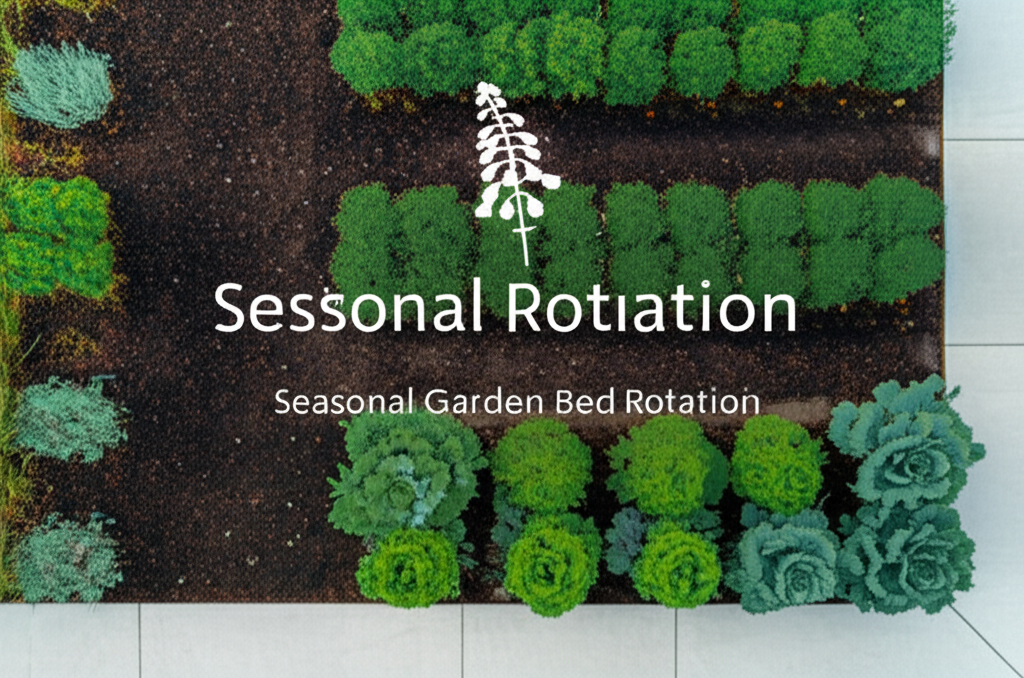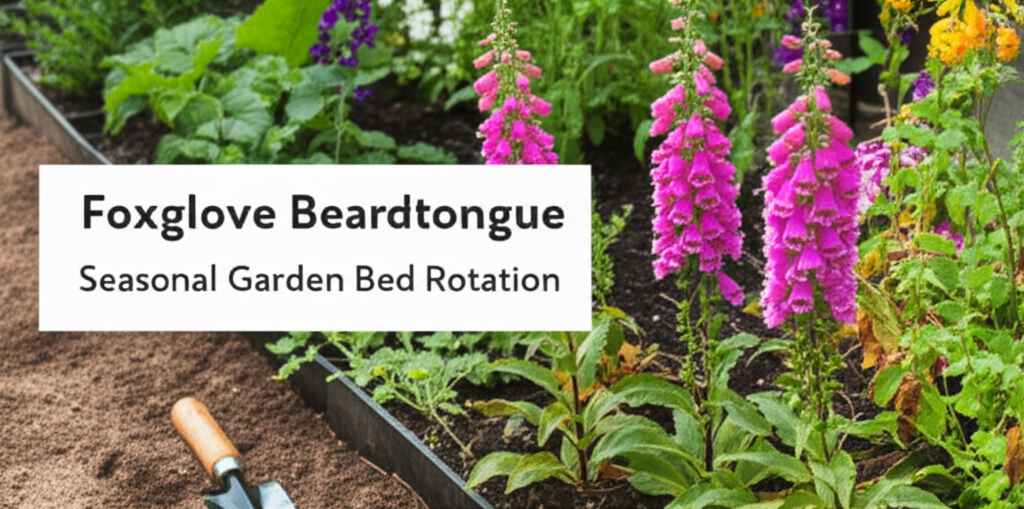Introduction to Foxglove Beardtongue (Penstemon digitalis)
Foxglove Beardtongue, scientifically known as Penstemon digitalis, is a captivating native perennial that graces many North American gardens with its elegant, trumpet-shaped flowers and robust growth. Belonging to the plantain family (Plantaginaceae), this adaptable plant is prized for its drought tolerance once established, its ability to attract pollinators, and its attractive foliage. While often considered a low-maintenance plant, understanding seasonal garden bed rotation can significantly enhance its health, vigor, and overall bloom production. This guide delves into the best practices for rotating Foxglove Beardtongue within your garden beds to ensure a thriving and visually stunning display year after year.
Understanding the Benefits of Garden Bed Rotation

Garden bed rotation, a practice borrowed from agricultural science, is crucial for maintaining soil health and preventing the build-up of pests and diseases. Even for seemingly robust plants like Foxglove Beardtongue, a thoughtful rotation strategy offers several key advantages:
- Improved Soil Health: Different plants have varying nutrient requirements and root structures. Rotating crops prevents the depletion of specific nutrients in the soil.
- Pest and Disease Management: Many pests and diseases are host-specific. By moving a plant to a new location, you disrupt the life cycles of these organisms, preventing them from establishing a permanent foothold in a particular area.
- Weed Control: Rotating plants with different growth habits can help suppress certain weed populations.
- Enhanced Plant Vigor: A fresh location can provide plants with optimal soil conditions, sunlight, and space, leading to stronger growth and more prolific flowering.
- Nutrient Cycling: Incorporating plants with different nutrient needs helps in a more balanced use and replenishment of soil resources.
Foxglove Beardtongue: Key Growth Requirements and Considerations
Before discussing rotation, it’s essential to understand what Foxglove Beardtongue needs to thrive. This knowledge will inform our rotation decisions.
Sunlight Preferences
Penstemon digitalis generally prefers full sun to partial shade.
- Full Sun (6+ hours of direct sunlight daily): This is ideal for the most abundant flowering and the strongest plant structure.
- Partial Shade (4-6 hours of direct sunlight): While it can tolerate some shade, flowering may be reduced, and the plant might become leggy.
Soil Conditions
Foxglove Beardtongue is remarkably adaptable but performs best in well-drained soils.
- Drainage is paramount: It dislikes waterlogged conditions, which can lead to root rot.
- Soil Type: It tolerates a range of soil types, from sandy to loamy, but prefers average to fertile soil.
- pH: It is adaptable to various soil pH levels, generally preferring slightly acidic to neutral conditions (pH 6.0-7.5).
Watering Needs
Once established, Foxglove Beardtongue is quite drought-tolerant.
- Newly Planted: Requires regular watering to help it establish a strong root system.
- Established Plants: Needs watering only during prolonged dry spells. Overwatering can be detrimental.
Spacing and Companion Planting
Proper spacing is crucial for air circulation, which helps prevent fungal diseases.
- Spacing: Typically planted 12-18 inches apart to allow for mature growth.
- Companion Plants: Pairs well with other native perennials, grasses, and plants that share similar sun and soil requirements. Avoid plants that require consistently moist soil.
Seasonal Garden Bed Rotation Strategy for Foxglove Beardtongue
A strategic rotation plan for Foxglove Beardtongue within your garden beds should consider a minimum of a 3-4 year cycle. This allows ample time for soil to recover and prevents the build-up of any potential soil-borne issues specific to Penstemon species.
Year 1: Planting Location A – Optimal Conditions
In its first year of rotation, Foxglove Beardtongue should be placed in a bed that offers its ideal conditions:
- Full sun exposure.
- Well-draining soil.
- A location that was not recently occupied by other Penstemon species or closely related plants.
Consider planting it alongside drought-tolerant companions such as Coneflowers (Echinacea spp.), Black-Eyed Susans (Rudbeckia spp.), or native grasses like Little Bluestem (Schizachyrium scoparium).
Year 2: Planting Location B – Similar Conditions
For the second year, move the Foxglove Beardtongue to a different bed that also meets its core requirements.
- Prioritize full sun and excellent drainage.
- Ensure this location did not have Penstemon last year.
This allows the previous location (Location A) to rest and replenish its soil nutrients.
Year 3: Planting Location C – Adaptable Conditions (if necessary)
If your garden design necessitates, Foxglove Beardtongue can tolerate partial shade, especially in hotter climates.
- If moving to a partial shade location, ensure it still has good drainage.
- Monitor for legginess and reduced flowering, adjusting watering if needed.
This bed should also not have hosted Penstemon in the preceding two years.
Year 4: Return to Planting Location A
After a 3-year hiatus, Location A should have recovered sufficiently to welcome Foxglove Beardtongue again.
- Before replanting, amend the soil with compost to boost fertility and improve structure.
- Observe the plants from the previous rotation to ensure no lingering issues are present.
Key Facts and Comparison of Rotation Locations
To illustrate the rotation concept, consider the following table outlining the characteristics of potential planting locations.
| Feature | Location A (Ideal) | Location B (Good) | Location C (Tolerable) |
|---|---|---|---|
| Sunlight | Full Sun (6+ hours) | Full Sun (6+ hours) | Partial Shade (4-6 hours) |
| Soil Drainage | Excellent | Very Good | Good |
| Soil Type | Loamy, well-draining | Sandy loam | Average garden soil |
| Previous Crop (3 years prior) | Non-Penstemon, beneficial plant residue (e.g., legumes) | Non-Penstemon, different plant family | Non-Penstemon, possibly a grass or bulb |
| Potential for Legginess | Low | Low | Moderate |
| Flowering Intensity | High | High | Moderate to High |
Implementation: Moving and Caring for Foxglove Beardtongue
The actual act of rotating plants requires careful timing and execution.
When to Rotate
The best time to move Foxglove Beardtongue is during its dormant season.
- Early Spring: As soon as the ground can be worked, but before new growth emerges.
- Fall: After the plant has finished flowering and foliage begins to die back, but before the ground freezes. This allows roots to establish before winter.
How to Move Plants
Handle the root ball with care to minimize transplant shock.
- Water the plant thoroughly a day or two before moving.
- Dig a wide trench around the plant, at least 6-8 inches away from the crown, to encompass as much of the root system as possible.
- Carefully lift the plant with its root ball. If the root ball is very large, consider using a tarp or wheelbarrow to move it.
- Prepare the new location by digging a hole twice as wide and as deep as the root ball.
- Amend the new soil with compost for improved fertility and structure.
- Place the plant in the new hole at the same depth it was previously growing.
- Backfill the hole with the amended soil.
- Water the transplanted plant deeply to settle the soil and reduce air pockets.
- Mulch around the base of the plant to retain moisture and suppress weeds.
Post-Rotation Care
Provide some extra attention to ensure a successful transition.
- Water regularly for the first few weeks, especially if the weather is dry, until new root growth is evident.
- Avoid fertilizing immediately after transplanting, as this can stress the roots. Wait until the plant shows signs of new growth.
- Monitor for signs of stress such as wilting or leaf discoloration.
Pros and Cons of Rotating Foxglove Beardtongue
Like any gardening practice, rotation has its advantages and potential drawbacks.
| Pros | Cons |
|---|---|
| Reduced risk of soil-borne diseases and pests specific to Penstemon. | Transplant shock can temporarily set back the plant’s growth and flowering. |
| Improved soil structure and nutrient availability over time in all rotated beds. | Requires planning and effort to move mature plants. |
| Enhanced overall plant health and vigor due to fresh soil conditions. | Potential for reduced flowering in the first year after transplanting as the plant re-establishes. |
| Greater resilience against environmental stressors. | May not be feasible in very small gardens or established perennial borders where plants are tightly integrated. |
| Promotes biodiversity by offering different microhabitats over time. | Requires good knowledge of your garden’s microclimates and soil history. |
Companion Planting Considerations in Rotation
When planning your rotation, consider the plants that will occupy the beds in the years Foxglove Beardtongue is absent, and the companions you choose when it is present.
Before Foxglove Beardtongue Returns
If Location A will host Foxglove Beardtongue in Year 4, what should be planted in Years 1, 2, and 3?
- Year 1: Legumes (e.g., clovers, peas) can fix nitrogen in the soil, benefiting the subsequent planting of Foxglove Beardtongue.
- Year 2: Deep-rooted plants like sunflowers or certain grasses can help break up soil compaction.
- Year 3: Plants with different nutrient needs or pest vulnerabilities, such as shallow-rooted annuals or plants from unrelated families.
With Foxglove Beardtongue
Choosing compatible companions in the same bed is also part of a holistic rotation strategy.
- Native Grasses: Little Bluestem, Prairie Dropseed (Sporobolus heterolepis).
- Other Drought-Tolerant Perennials: Coreopsis, Asters, Salvias.
- Pollinator attractors that bloom at different times to extend the season of interest.
Avoid planting Foxglove Beardtongue with aggressive spreaders or plants that require consistently moist soil.
Addressing Challenges and Variations
While the 3-4 year rotation is a good general guideline, garden realities can vary.
Small Gardens
In very small gardens where extensive rotation is difficult, focus on improving soil health in place.
- Incorporate generous amounts of compost annually around the Foxglove Beardtongue.
- Top-dress with aged manure or other organic matter.
- Consider dividing the plants every 3-4 years instead of moving them entirely, which can refresh the root system and improve vigor.
Established Perennial Borders
If your Foxglove Beardtongue is part of a mature perennial border, carefully consider the impact of moving it on surrounding plants.
- Plan your moves during the dormant season to minimize disruption.
- Take extra care to avoid damaging the roots of neighboring plants.
- Be prepared for a slight aesthetic gap in the border during the transition year.
Soil Amendment Best Practices
Soil amendment is key to successful rotation.
- Use compost: It is the most beneficial amendment, improving soil structure, drainage, and fertility.
- Aged manure: Provides nutrients and improves soil organic matter.
- Leaf mold: Excellent for improving soil structure and water retention.
- Avoid over-fertilizing with synthetic fertilizers, which can lead to weak, leggy growth and make plants more susceptible to disease.
Conclusion: Cultivating a Thriving Foxglove Beardtongue Garden
Implementing a seasonal garden bed rotation strategy for your Foxglove Beardtongue is an investment in the long-term health and beauty of your garden. By understanding the plant’s needs and following a cycle of moving it to fresh, suitable locations, you actively contribute to a more robust ecosystem, minimizing pest and disease issues while maximizing its stunning floral display. This proactive approach ensures that your Foxglove Beardtongue continues to be a vibrant, pollinator-friendly centerpiece for years to come. Remember to observe your plants, adapt your practices as needed, and enjoy the rewards of a well-managed garden.


